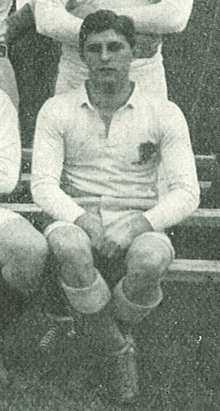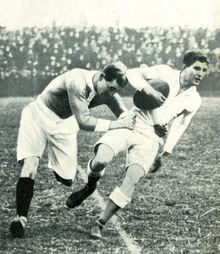Cyril Lowe
Cyril Nelson "Kit" Lowe, MC, DFC (7 October 1891 – 6 February 1983) was an English rugby union footballer who held England's international try scoring record for over sixty years, a First World War flying ace credited with nine victories, and supposedly the inspiration for W. E. Johns' character "Biggles".[1]
 | |||||||||||||||||||||||||||||
| Birth name | Cyril Lowe | ||||||||||||||||||||||||||||
|---|---|---|---|---|---|---|---|---|---|---|---|---|---|---|---|---|---|---|---|---|---|---|---|---|---|---|---|---|---|
| Date of birth | 7 October 1891 | ||||||||||||||||||||||||||||
| Place of birth | Holbeach, Lincolnshire, England | ||||||||||||||||||||||||||||
| Date of death | 6 February 1983 (aged 91) | ||||||||||||||||||||||||||||
| School | Dulwich College | ||||||||||||||||||||||||||||
| University | Cambridge University | ||||||||||||||||||||||||||||
| Rugby union career | |||||||||||||||||||||||||||||
| |||||||||||||||||||||||||||||
| Military career | |||||||||||||||||||||||||||||
| Allegiance | United Kingdom | ||||||||||||||||||||||||||||
| Service/ | British Army Royal Air Force | ||||||||||||||||||||||||||||
| Years of service | 1914–1919 1921–1944 | ||||||||||||||||||||||||||||
| Rank | Group Captain | ||||||||||||||||||||||||||||
| Unit |
| ||||||||||||||||||||||||||||
| Commands held | |||||||||||||||||||||||||||||
| Battles/wars | World War I World War II | ||||||||||||||||||||||||||||
| Awards | Military Cross Distinguished Flying Cross | ||||||||||||||||||||||||||||
Early life
Lowe was born in Holbeach, Lincolnshire. He attended Dulwich College where he was a boarder in Orchard House.[2] He edited the school magazine, The Alleynian from 1910-11, as his fellow alumnus P. G. Wodehouse had done previously. At Dulwich, he excelled at a number of sports, and represented the school in boxing, athletics, swimming, cricket and rugby.[3] He captained the Athletics squad in 1911 and in the same year played for the first XI cricket squad. In this same cricket side, he played alongside future England captain, Arthur Gilligan, the future Essex wicket-keeper Frank Gilligan and R. K. Nunes; the future captain of the West Indies. Eclipsing these sporting achievements was his record as a rugby player. He was in the side first XV from 1908 and was in the unbeaten first XV rugby union squad in 1909; which contained five future internationals dubbed the 'Famous Five'.[4] These five would all go on to play in the 1913 Varsity match, (and also produced the captains of both Oxford and Cambridge in 1919), and all of whom served in the First World War. They were Eric Loudoun-Shand and Grahame Donald who both went on to play for Scotland, W. D. Doherty who went on to play for and captain Ireland, J. E. Greenwood who went on to play for and captain England and Cyril Lowe himself. He then went on to captain the side in 1910–11. Despite his sporting prowess, Lowe was not physically imposing, standing 5 ft 8 in (1.73 m) and weighing around nine-and-a-half stone (133 lb (60 kg)) while at school. His small stature led to his nickname at school being "Tich" Lowe.[2] He was described by the school magazine, The Alleynian, as "A first rate centre three-quarter. Very fast, with a capital pair of hands, a first-rate dodge on a dry ground, and a good pair of feet on the wet."
He went on to Cambridge University where he won rugby blues in 1911, 1912 and 1913, making him a rare triple blue.
Rugby career
Cyril Lowe, whilst still at Cambridge, was called up to play for England in 1913. This was to be the beginning of an international career that spanned either side of the First World War, in which he scored a record 18 tries in 25 internationals and was on the losing side only three times, twice to Wales and once to South Africa. He played in four Grand Slam-winning sides until his retirement in 1923. In 1913 and 1914 he won back-to-back Five Nation Grand Slams and his eight try haul in 1914 remains a Championship record, only ever equalled by one other player, Ian Smith of Scotland.[5] His tally of tries remained a record until overtaken by another RAF pilot, Rory Underwood, in 1989.
At club level, after leaving Cambridge, Lowe represented Blackheath, and was later the RAF representative on the Rugby Union Committee.
Lowe's sporting career was interrupted by the outbreak of hostilities in 1914, and he did return to play for England until 1920. He retired from international rugby in 1923 with 25 caps, and would have gained more were it not for the war. His career total 18 tries remained an English record until it was equalled and later surpassed by Royal Air Force pilot Rory Underwood in 1989, 66 years after Lowe's retirement. It has subsequently been achieved by other players, though internationals are more frequent in the modern game and are generally higher scoring.
International tries

Military career
First World War
Joining the army soon after the outbreak of the First World War, Lowe was commissioned into the Army Service Corps as a temporary second lieutenant on 31 August 1914.[6] He was promoted to lieutenant on 20 January 1915,[7] and to captain on 30 April 1916.[8]
Lowe was transferred to the General List to serve in the Royal Flying Corps, and appointed a flying officer on 30 September 1916.[9] He was posted to No. 11 Squadron,[10] and was appointed a flight commander on 11 February 1917.[11] Flying a F.E.2b with observer/gunner Second Lieutenant G. Masters, Lowe gained his first victory on 15 March 1917, destroying a Type C aircraft over Bailleul. On 24 March, he drove down out of control an Albatros D.III over Fontaine-lès-Croisilles, but was wounded when shot down by Reinhold Jörke later on the same day. Lowe returned to flying duty in early-1918, when posted to No. 24 Squadron, flying the S.E.5a single-seat fighter. Between 23 April and 1 July 1918, Lowe scored seven more victories, sharing one with Lieutenant Ronald T. Mark, destroying three and driving down four more out of control, to bring his total to nine.[10]
Lowe was subsequently awarded the Distinguished Flying Cross, which was gazetted on 3 August 1918. His citation read:
Capt. Cyril Nelson Lowe, M.C. This officer has destroyed five enemy machines and driven down two others out of control. On one occasion he attacked two enemy triplanes, although at the time only one of his guns was serviceable; he shot down one of the machines in flames. On another occasion, while leading a formation of eight scouts he engaged a hostile formation of twenty-six machines. Having shot down a Fokker biplane he went to the assistance of one of our scouts and drove the enemy machine down to 500 feet; at this low altitude half of a blade of his propeller was shot off by fire from the ground.[12]
This was followed by the award of the Military Cross, gazetted on 16 September 1918. The citation read:
T./Capt. Cyril Nelson Lowe, Gen. List, attd. R.A.F. For conspicuous gallantry and devotion to duty. This officer and another pilot were escorting a formation of machines engaged on a bombing raid when seven enemy scouts attacked the bombers. They both attacked these scouts, but at the outset this officer's machine was set on fire, and the other pilot's right hand top plane broke. During the fight that ensued each came to the rescue of the other. The other pilot first caused Capt. Lowe's pursuer to break off his attack, and then Capt. Lowe shot down the scout attacking his comrade. The action of both these officers, in practically unmanceuvrable machines, in coming to the rescue of each other in turn, showed courage and self-sacrifice of a very high order.[13]
Lowe left the RAF after the war, being transferred to unemployed list on 2 March 1919.[14]
Post-war career
Lowe returned to serve in the Royal Air Force on a three-year short service commission with the rank of flight lieutenant on 12 January 1921,[15][16] but this was later cancelled and he was granted a permanent commission on 17 April 1923, backdated to January 1921.[17] He was promoted to squadron leader on 1 July 1925,[18] and was posted to the Headquarters of the Special Reserve and Auxiliary Air Force on 7 September 1925.[19] However, on 14 September 1925 he was appointed temporary commander of No. 602 City of Glasgow (Bombing) Squadron of the Auxiliary Air Force.[20][21] On 1 April 1926, he was appointed commander of No. 1 Squadron, based in Iraq,[22] and on 1 November 1926 was transferred to No. 6 Armoured Car Company.[23]
Lowe eventually returned to England, and was commander of No. 43 Squadron, based at RAF Tangmere by June 1928,[24] the squadron becoming highly regarded for their aerobatic displays.[25] He was posted to No. 2 Flying Training School, based at RAF Digby, on 18 November 1930.[26] Lowe was promoted to wing commander on 1 January 1933,[27] and in August was appointed chief instructor of the Oxford University Air Squadron, succeeding Keith Park, and being the first Cambridge man to command the Oxford Squadron.[28] On 31 December 1937 Lowe was promoted to group captain,[29] and retired from the Royal Air Force on 7 October 1944.[30]
Lowe died in 1983, aged 91.
See also
- List of top English points scorers and try scorers
References
- Westerby, John. "Sky is the limit for Cueto after overtaking Biggles on take-off". The Times. Archived from the original on 29 June 2011. Retrieved 23 April 2015.
- "Eminent Old Alleynians : Sport". Dulwich College. Archived from the original on 19 May 2011.
- "Statsguru – Player analysis – Cyril Lowe". ESPN Scrum. 2015. Retrieved 23 April 2015.
- Piggot, Jan (2008). Dulwich College: A History, 1616–2008. ISBN 0-9539493-2-X.
- Mudaly, L. (13 February 2011). "England 59 Italy 13 – The Rugby World Index Ratings". Rugby World. Retrieved 23 April 2015.
- "No. 28898". The London Gazette (Supplement). 8 September 1914. p. 7195.
- "No. 29059". The London Gazette (Supplement). 2 February 1915. p. 1193.
- "No. 29588". The London Gazette. 19 May 1916. p. 4975.
- "No. 29790". The London Gazette (Supplement). 17 October 1916. p. 10067.
- "Cyril Nelson Lowe". The Aerodrome. 2015. Retrieved 23 April 2015.
- "No. 29958". The London Gazette. 23 February 1917. p. 1881.
- "No. 30827". The London Gazette (Supplement). 3 August 1918. p. 9201.
- "No. 30901". The London Gazette (Supplement). 16 September 1918. p. 10980.
- "No. 31239". The London Gazette. 18 March 1919. p. 3635.
- "No. 32209". The London Gazette. 28 January 1921. p. 781.
- "Short Service Commissions". Flight. XIII (632): 87. 3 February 1921. Retrieved 23 April 2015.
- "No. 32815". The London Gazette. 17 April 1923. p. 2816.
- "No. 33063". The London Gazette. 3 July 1925. p. 4456.
- "Royal Air Force: Appointments". Flight. XVII (872): 589. 10 September 1925. Retrieved 23 April 2015.
- "Royal Air Force: Appointments". Flight. XVII (879): 711. 29 October 1925. Retrieved 23 April 2015.
- "Auxiliary Air Force". Flight. XVII (876): 663. 8 October 1925. Retrieved 23 April 2015.
- "Royal Air Force: Appointments". Flight. XVIII (903): 231. 15 April 1926. Retrieved 23 April 2015.
- "Royal Air Force: Appointments". Flight. XVIII (937): 819. 9 December 1926. Retrieved 23 April 2015.
- "The Midland Air Pageant". Flight. XX (1016): 445. 14 June 1928. Retrieved 23 April 2015.
- "No. 43 (Fighter) Squadron". Flight. XXII (1134): 1042–1044. 19 September 1930. Retrieved 23 April 2015.
- "Royal Air Force: Appointments". Flight. XXII (1145): 1423. 5 December 1930. Retrieved 23 April 2015.
- "No. 33898". The London Gazette (Supplement). 30 December 1932. p. 16.
- "Oxford University Air Squadron". Flight. XXVI (1340): 904. 30 August 1934. Retrieved 23 April 2015.
- "No. 34468". The London Gazette. 31 December 1937. p. 8194.
- "No. 36748". The London Gazette (Supplement). 13 October 1944. p. 4737.